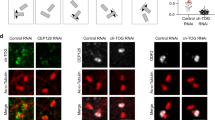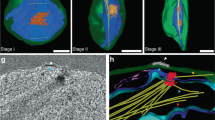Abstract
THE microtubule cytoskeleton of animal cells does not assemble spontaneously, but instead requires the centrosome. This organelle consists of a pair of centrioles surrounded by a complex collection of proteins known as the pericentriolar material (PCM)1. The PCM is required for microtubule nucleation2. The minus, or slow-growing, ends of microtubules are embedded in the PCM and the plus, or fast-growing, ends project outwards into the cytoplasm during interphase, or into the spindle apparatus during mitosis, γ-Tubulin is the only component of the PCM that is so far implicated in microtubule nucleation3–6. Here we use immuno-electron microscopic tomography to show that γ-tubulin is localized in ring structures in the PCM of purified centrosomes without microtubules. When these centrosomes are used to nucleate microtubule growth, γ-tubulin is localized at the minus ends of the microtubules. We conclude that microtubule-nucleating sites within the PCM are ring-shaped templates that contain multiple copies of γ-tubulin.
This is a preview of subscription content, access via your institution
Access options
Subscribe to this journal
Receive 51 print issues and online access
$199.00 per year
only $3.90 per issue
Buy this article
- Purchase on SpringerLink
- Instant access to full article PDF
Prices may be subject to local taxes which are calculated during checkout
Similar content being viewed by others
References
Kellogg, D. R., Moritz, M. & Alberts, B. M. A. Rev. Biochem. 63, 639–674 (1994).
Gould, R. R. & Borisy, G. G. J. Cell Biol. 73, 601–615 (1977).
Oakley, B. R. Trends Cell Biol. 2, 1–5 (1992).
Joshi, H. C., Palacios, M. J., McNamara, L. & Cleveland, D. W. Nature 356, 80–83 (1992).
Felix, M.-A., Antony, C., Wright, M. & Maro, B. J. Cell Biol. 124, 19–31 (1994).
Stearns, T. & Kirschner, M. Cell 76, 623–637 (1994).
Moritz, M. et al. J. Cell Biol. 130, 1149–1159 (1995).
Koster, A. J., Chen, H., Sedat, J. W. & Agard, D. A. Ultramicroscopy 46, 207–227 (1992).
Koster, A. J. et al. Microsc. Soc. Am. Bull. 23, 176–188 (1993).
Tilney, L. G. et al. J. Cell Biol. 59, 267–275 (1973).
Evans, L., Mitchison, T. & Kirschner, M. J. Cell Biol. 100, 1185–1191 (1985).
Zheng, Y., Wong, M. L., Alberts, B. & Mitchison, T. Nature 378, 578–583 (1995).
Fung, J. C. et al. J. struct. Biol. (in the press).
Author information
Authors and Affiliations
Rights and permissions
About this article
Cite this article
Moritz, M., Braunfeld, M., Sedat, J. et al. Microtubule nucleation by γ-tubulin-containing rings in the centrosome. Nature 378, 638–640 (1995). https://doi.org/10.1038/378638a0
Received:
Accepted:
Issue date:
DOI: https://doi.org/10.1038/378638a0
This article is cited by
-
Physiological roles of chloride ions in bodily and cellular functions
The Journal of Physiological Sciences (2023)
-
Small molecule-nanobody conjugate induced proximity controls intracellular processes and modulates endogenous unligandable targets
Nature Communications (2023)
-
The γ-tubulin meshwork assists in the recruitment of PCNA to chromatin in mammalian cells
Communications Biology (2021)
-
Centrosome: A Microtubule Nucleating Cellular Machinery
Journal of the Indian Institute of Science (2021)
-
Direct binding of CEP85 to STIL ensures robust PLK4 activation and efficient centriole assembly
Nature Communications (2018)



